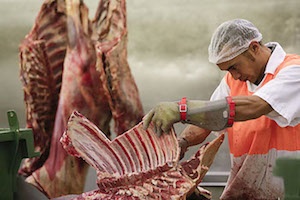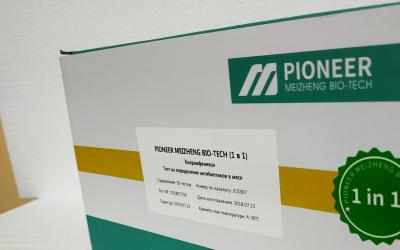Created immortal stem cells for growing meat

The production of cellular MEAT requires muscle and fat cells with a high ability to grow and divide. The production of such products is expensive and difficult to scale. As a rule, researchers have to isolate animal stem cells themselves or use model cell lines of less important species, such as mouse cells.
Normal muscle stem cells taken from live animals to begin culture typically only divide about 50 times before they begin to age and cease to be viable. Although theoretically even these stem cells can produce a significant amount of meat, the immortalized cells developed by scientists have a number of advantages over them. One of them is the ability to produce more mass to create meat. Another plus is that the availability of immortalized cells lowers the barrier to entry for other companies and researchers into cellular meat production .
it took two steps to convert ordinary bovine muscle stem cells into immortalized stem cells. Most cells, as they divide and age, begin to lose DNA at the ends of their chromosomes, called telomeres. Cells "wear out" like ropes. This leads to errors in copying or repairing DNA, loss of genes and, ultimately, cell death.
The researchers engineered bovine stem cells to constantly renew their telomeres, effectively keeping the chromosomes "young" and ready for the next cycle of replication and cell division. The second step to cell immortality was to force them to continuously produce a protein that stimulates a critical step in cell division. This speeds up the process and helps the cells grow faster.
Muscle stem cells are not a food-grade end product. They must not only divide and grow, but also differentiate into mature muscle cells. The scientists successfully differentiated the engineered stem cells into mature muscle cells, but not completely identical to animal cells or conventional bovine stem cells.
Scientists will further investigate whether these cells can replicate the taste and texture of natural meat.
Read together with it:
- Матричные РНК-вакцины от COVID продлили жизнь тяжелых раковых больныхМатричные РНК-вакцины против коронавируса продлили жизнь пациентам, больным раком в самой тяжелой, четвертой стадии, сообщает The Washington Post. К такому выводу пришли исследователи Онкологического центра имени М. Д. Андерсона Техасского университета и Университета Флориды. «Эти данные невероятно интересны, но они должны быть подтверждены в ходе третьего этапа клинических испытаний», — заявил од...
- Omsk Region has significantly increased poultry production.According to Omskstat, the manufacturing industry's production index was 103.4%. The largest growth was observed in the production of computers, electronics, and optical products (+89.2%). At the same time, some sectors, such as metallurgy and mining, showed declines: metallurgy decreased output by 12.5%, and mining by 17.3%. A deterioration was also observed in the energy sector, where production...
- Chinese scientists have discovered a new natural meat preservative.In an experiment, cinnamon oil effectively inhibited the growth of Shewanella putrefaciens, a microorganism responsible for the decay of protein products even at low storage temperatures. Even at minimal concentrations, the oil inhibited bacterial growth, damaged their internal and external membranes, disrupted cell integrity, and caused protein and nucleic acid leakage. Additionally, the essentia...
- Russia is developing a new swine flu vaccine based on two strains.The vaccine is being developed using two strains: pandemic H1N1 and classical H3N2, isolated in the Kursk region and Udmurtia. According to Dmitry Biryuchenkov, HEAD of the swine disease prevention laboratory at the All-Russian Research Institute of Animal HEALTH, the vaccine has already demonstrated high efficacy and safety for pregnant sows and piglets. Development is expected to be completed in...
- Komi's food industry grew by 3.2% in the first eight months of 2025.The MEAT industry led the growth. Poultry and by-product production increased by 11.4%. The finished meat products segment also saw significant growth: production of semi-finished meat products increased by 8.9%, and sausages by 7.4%. Positive dynamics are also observed in the dairy industry. Cheese production increased by 6%, and raw MILK processing volumes grew by 1.3%. The bakery market also de...
- About shashlik, point of view, and dragons. An interview with Academician D.A. Baimukanov.PIONERPRODUKT.by continues its series of interviews with the eminent Kazakhstani scientist Dastanbek Asylbekovich Baimukanov , recorded by his younger brother, Syzdyk Asylbekovich Baimukanov. The first interview is titled: "A Story of Shepherds, Sheep, and Freedom . " The second interview is titled: " On Beshbarmak, Money, MEAT, Traditions, Genetics, and Selective Breeding." We remind you that num...
- A large livestock complex has opened in Parokhonsky, Pinsk District.October 9, Brest. A large livestock complex opened on October 9 on the territory of Parokhonskoye JSC in the Pinsk District , BelTA reports. Construction in the village of Kamen began in November 2024. Workers completed the project this September. The farm used its own funds and also secured a loan. Parokhonskoye is focusing on MILK and MEAT production. Facilities are being reconstructed to increa...
- Krasnodar Krai: The country's leaders in meat productionTo ensure comfortable conditions, the farm has renovated a special hangar where the chicks are housed in ideal conditions immediately after delivery. Importantly, the farmers maintain high feeding standards, which directly impacts the quality of the MEAT. Individual orders are also processed , allowing them to deliver environmentally friendly products to major cities. Further renovation of the han...
- In the Altai region, there is a decrease in livestock numbers while dairy production is growing.The number of cows decreased to 223,800 (-7.2%), while sheep and goat farming saw the most significant decline—down 10.6% to 133,900. The pig population decreased by 8.4%, reaching 286,500. Despite this, agricultural production volumes remain stable and, in some areas, are even increasing. From January to August 2......




























































